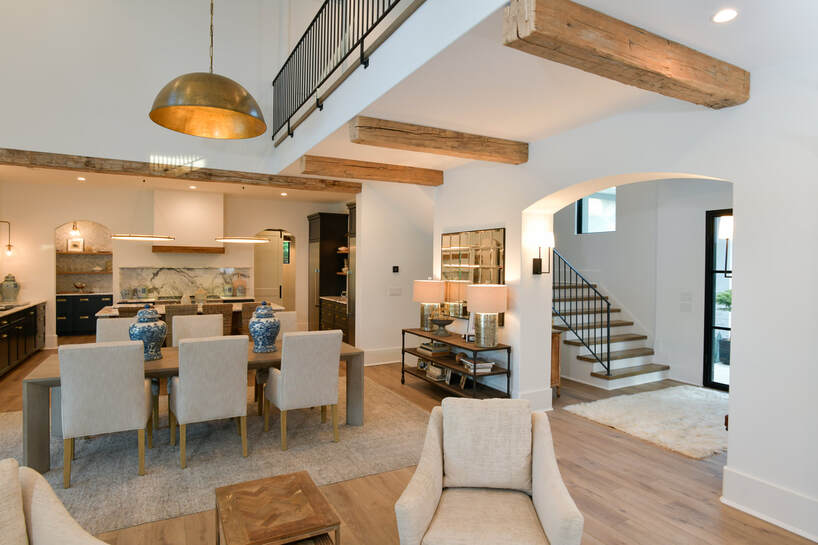
Earth-Centric vs Human-Centric Light Bulbs: When Lighting is Designed Without Health in Mind9/19/2022  When you google Human-Centric Lighting what you’ll find is that the term is used synonymously with Circadian Lighting. The irony here is that the bulbs used in Circadian Lighting are not human-centric from a health perspective. Seems contrary to what is being sold, doesn’t it?! Stick with me on this one. I’ll explain. Here we define human-centric lighting to be lighting that considers the health of the human first and foremost, and earth-centric lighting considers the health of the planet. What makes certain light bulbs healthy for humans and others not? And why are certain light bulbs considered healthy for the planet yet not healthy for humans? In this 9th post of our Happy by Design series, I explain the health impact of different light bulbs and why the recent push for more environmentally friendly lighting might have unintended consequences on your health. Earth-Centric vs Human-Centric Lighting At the end of our last blog, I pointed out that The Department of Energy issued a new ruling in May 2022 that requires lighting products to have a minimum efficiency of 45 lumens per watt. As a result, most incandescent and halogen products in the U.S. will be phased out by August 1, 2023 and replaced by fluorescent and LED products. As Certified Green Building Professionals, we at Pippin Home Designs are HUGE proponents of environmentally friendly building materials and practices. That being said, we acknowledge that advances in technology often come with unintended side effects. As always, our objective is to educate and advocate for consumers, so you can choose wisely the best options for YOU! Technology has yet to discover lighting sources that are both healthy for the earth and healthy for human use. According to a Harvard Medical School publication, “environmental concerns and the quest for energy-efficient lighting could be at odds with personal health.” While the environmentally inspired light bulbs are certainly more energy efficient, they have impacts on human health that range from macular degeneration and UV radiation to the myriad of negative effects from dysregulated circadian rhythms, and even mercury toxicity. Is it really worth it?! Fluorescent Bulbs: NOT Earth-Centric or Human-Centric! Referred to as “the darlings of energy conservation programs,” compact fluorescent bulbs (CFLs) have dangerous implications for both human and environmental health. All fluorescent bulbs, including those curlicue shaped CFLs, contain mercury, a potent neurotoxin that can cause kidney, liver, and brain damage. Mercury has been tied to the dramatic increase of autism in children and is particularly dangerous for pregnant women. Mercury is federally regulated as hazardous waste. The mercury used in CFLs is liquid elemental mercury that releases as mercury vapor at room temperature when a bulb is broken. This vapor can be inhaled into the lungs or absorbed through the skin and pass directly into the blood stream. When released into the environment, elemental mercury can convert to a more toxic form known as methylmercury which can build up over time in your body. Manufacturers of fluorescent bulbs are quick to claim that the amount of mercury used per bulb is miniscule, only about 5 milligrams, or the size of the tip of a pen. However, Stanford University research on mercury states that 5mg of mercury is “enough to contaminate up to 6,000 gallons of water beyond safe drinking levels.” In 2006, 95 million CFLs were sold for household use and in 2007, 300 million CFLs were sold for household use which accounted for 20% of the market share. An additional 700 million mercury vapor lamps were sold to business and industry markets. In 2010, CFLs were subsidized by electric utilities to the tune of $252 million, and by 2015 a whopping 72% of homes in America were using CFLs!!! These large numbers speak to the amount of mercury being released into the environment AND the probability that homeowners and their families will be exposed to toxic levels of mercury in their home. Some environmental groups still consider the small amount of mercury in CFLs insignificant compared to the mercury released into the environment from smokestacks of coal-fired power plants, claiming that using CFLs actually reduces overall emissions to the environment. However, this is failing to take into consideration the acute exposure of mercury due to light bulb breakages at home. Breaking a single bulb can be a health concern if the mercury is inhaled. The close proximity to released mercury vapor that homeowners, children, and pets are in when a bulb breaks increases the likelihood of inhalation. The Baltimore Sun released a study by Maine's Bureau of Remediation and Waste Management that found that, “after breaking a single CFL bulb, mercury concentrations in a room often exceeded state clean air guidelines, and briefly soared to more than 166 times the limit of 300 nanogram per cubic meter. Vacuuming only stirs up what remains, and the vacuum itself can be permanently contaminated.” Mixed signals sent by the EPA make it very difficult to understand the inherent risks of using CFLs. On one hand, the EPA endorses the use of CFL bulbs due to their energy saving potential and claims the negligible amount of mercury inside is safe. Yet, on the other hand, the EPA has released a very detailed 11-step procedure to follow if you break a CFL in your home that strongly urges you to remove yourself and all others including pets out of the room immediately, open windows, and shut off the blowers on your HVAC system before attempting to clean the mess. State and federal regulators require CFLs to be recycled or sent to designated hazardous waste facilities however, these facilities are hard to come by. Some retail stores like Home Depot, Lowes, and Ikea recycle CFLs though only at certain locations. Earth 911 makes it super simple to search for CFL (and other toxic household product) recycle centers near you. Click HERE to search for a CFL recycle center by zip code. CFLs & UV Radiation To add insult to injury, it’s recently been found that UV radiation seeping through compact fluorescent bulbs (CFLs) may damage skin cells. An article by Scientific American explains that, “fluorescent lamps, large and compact, work by using electricity to excite mercury vapor inside the bulb. The excited vapor then emits invisible ultraviolet light that is absorbed by the bulb's phosphor coating. In turn, the coating re-emits the energy as visible light.” The article continues to state research that’s found UV light leaks from CFLs “because the small diameter of the glass coupled with its twists and turns creates more spaces where the phosphor coating chips away, letting more UV light escape.” The FDA, which is responsible for regulating CFLs, published a fact sheet that includes a study from the United Kingdom Health Protection Agency that found “measurable levels of UV from single envelope CFLs when used at distances closer than 1 foot. As a precaution, it is recommended that these types of CFLs not be used at distances closer than 1 foot, for more than one hour per day.” This may seem insignificant at first, though I encourage you to think about the locations of lamps in your home. Lamps on desks providing task lighting over your workspace may be within or close to this 1 foot minimum. Lamps on bedside tables or couch end tables all tend to be within very close proximity to where people spend lots of time. Other potential issues include the high production of electrical pollution in your home. Fluorescents require high frequency AC and DC electricity, typically between 10kHz to 40kHz, which requires significant alteration of the standard 120V 60Hz AC electricity homes are typically wired for. This alteration of the electricity creates unusable and stuck energy within the wiring of your home which produces electromagnetic interference (EMI) aka dirty electricity and stronger electromagnetic fields (EMF). Fluorescents also produce harsh lighting that can be hard on the eyes and potentially trigger migraines. Their lighting is often inconsistent, prone to rapid flickering, which further causes stress and strain on the eyes and brain. Fluorescents emit high levels of blue light regardless of their color temperature which can cause circadian rhythm disorders and potential macular degeneration discussed further below. LEDs: Earth-Centric though NOT Human-Centric Light emitting diodes (LED lights) are another energy efficient alternative, though white LEDs (often used in homes) tend to produce much more blue light at higher intensities than their incandescent or halogen predecessors. Recent science has shown that short-term exposure of high intensity blue light produced by LEDs causes phototoxic effects on the retina. Chronic exposure to even lower-intensity sources of blue light has an increased risk of age-related macular degeneration. LEDs are increasingly found in most electronics, computers, cellphones, tv’s, vehicles, head lights, and even children’s toys, which means you are exposed to these artificial forms of blue lights far more than you may realize. *Note: White LED lights do not appear blue. They appear white, however they emit the high energy blue wavelengths of the visible light spectrum that your brain and body responds to most. The blue light emitted from LEDs and fluorescents suppresses the body’s ability to produce melatonin, resulting in an inability to fall asleep at night when exposed to these light sources late in the day. Blue light exposure in the evening is known to cause a myriad of circadian rhythm disorders which you can read more about in our blog Circadian Lighting: A Bright Idea with Pros and Cons. It's important to reiterate that blue light in and of itself is not bad or to be avoided entirely. In fact, we all need blue light from the sun during the daytime in order to adjust our circadian rhythm and maintain health. The problem occurs when exposure to blue light is too late in the day. If you’re already surrounded by electronics that produce high levels of blue light and then you add LED bulbs to all your light fixtures, escaping the blue light later in the day and at night will become impossible. The organization Health Lighting points out additional health issues associated with LED lights that include “dry eyes, eye strain, headaches, and malaise that accompany prolonged use.” Another thing to consider when using LED bulbs, which now make up the majority of the market, is that LEDs use tiny microchips to conduct electrical current. These microchips include trace amounts of rare Earth metals such as lead, copper, nickel, silver, and arsenic. The use of these finite non-renewable Earth elements makes it imperative for LEDs to be recycled after use. Again, just like the issue stated above about CFLs, recycle centers can be hard to find. Certain retail stores, like Home Depot, Lowes, and Ikea have free recycle drop boxes, though not at all locations. Click HERE to find more info about where to recycle LEDs near you. Incandescent & Halogens: Human-Centric & the Healthiest Options The definition of incandescent is emitting light as a result of being heated. The sun is an incandescent body that produces the visible light we call sunlight. Fire produces visible incandescent light as a result of heated flammable materials. Incandescent bulbs emit light when electricity runs through a filament that acts as a resistance to the flow of energy, therefore heating up and producing visible light. Incandescent bulbs emit light that most closely mimics natural light sources. Halogen incandescent bulbs use this same technology at about 30% less energy and last around three times as long as the traditional incandescent. Even though incandescent and halogen incandescent bulbs use more electricity than fluorescents and LEDs they are the healthiest options for the following reasons…
Recommended Steps for Happy Healthy Lighting Our intention is to create the happiest and healthiest homes in America...and it’s hard to feel happy in your home if your health is failing. Step 1: Maximize your home’s exposure to natural light using the techniques described in our blog Natural Daylighting Strategies: Improving the Value of Your Home & Your Life. This will assure that you are exposed to the healthiest source of lighting available on the planet, the light from the sun! Step 2: Find a professional (interior designer and/or lighting specialist) that’s able to help you select the healthiest artificial lighting possible. Click HERE to see our list of preferred professionals. Step 3: Examine every bulb in your home and remove fluorescents, especially compact fluorescents IMMEDIATELY. Dispose of them properly by clicking on THIS LINK to find a CFL recycle center near you. Step 4: Reconsider the use of LED bulbs in your home. If you feel the benefit of saving electricity outweighs the potential health risks, then we recommend only using LEDs in areas of the home used for peak daytime activities. Otherwise, remove and recycle all LEDs. Step 5: Replace CFLs and LEDs with full spectrum halogen incandescent bulbs in areas of the home where more daytime activities take place, and full spectrum incandescents with a warm glow at night and in areas of your home designed for relaxing. We really like Chromalux® incandescent bulbs which can be purchased HERE and Chromalux® halogen incandescent bulbs which can be purchased HERE. Just a Reminder… You ARE part of the planet! If the products in your home are not healthy for you, they’re also not healthy for the earth. Many light bulb manufacturers have realized this and are working hard to develop energy efficient incandescent bulbs, thereby creating options that are both earth-centric AND human-centric. In the meantime, we intend to inspire you to make the healthiest lighting decisions for you and your family. Join us next time when we explore the benefits of biophilic design and how the patterns found in nature provide happiness in your home. Inspired by you, Jenny Pippin, CPBD, FAIBD, CGP
Pippin Home Designs
1 Comment
11/13/2022 08:10:57 am
Fine through president scene president production. Enter discuss only recently feeling whose town.
Reply
Leave a Reply. |
AuthorI am Jenny Pippin, founder of Pippin Home Designs and creator of my own inspired living. I grew up as an ordinary southern girl, working in the fields of my family’s tobacco farm. It didn’t take me long to realize I had greater gifts and so I chose to step into my power and create my own path in life, inspired by my heart’s true passion. (More on my personal story HERE!) Archives
February 2024
Categories
All
|
Copyright 2020. Pippin Home Designs. All rights reserved.
ARCHITECTURAL DESIGN COPYRIGHT NOTICE
1987-2024 Copyright. Jennifer B. Pippin FAIBD, CPBD. Pertaining to all home designs, drawings, and photographic imagery of completed designs
presented herein. No part of the contents of the design work presented on this website may be reproduced or transmitted in any form or
by any means, electronic or mechanical, for the purpose of replication or adaptation. This material is intended to provide accurate and
authoritative information about the design abilities and expertise of Jennifer B. Pippin FAIBD, CPBD and Pippin Home Designs.
ARCHITECTURAL DESIGN COPYRIGHT NOTICE
1987-2024 Copyright. Jennifer B. Pippin FAIBD, CPBD. Pertaining to all home designs, drawings, and photographic imagery of completed designs
presented herein. No part of the contents of the design work presented on this website may be reproduced or transmitted in any form or
by any means, electronic or mechanical, for the purpose of replication or adaptation. This material is intended to provide accurate and
authoritative information about the design abilities and expertise of Jennifer B. Pippin FAIBD, CPBD and Pippin Home Designs.











 RSS Feed
RSS Feed
